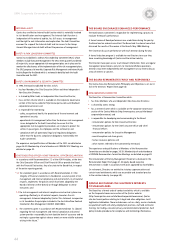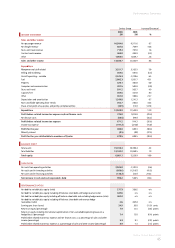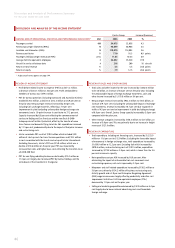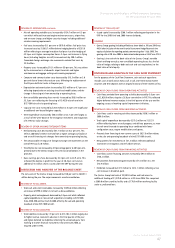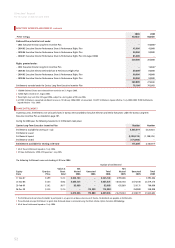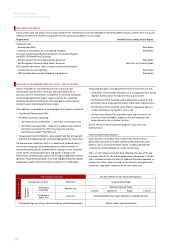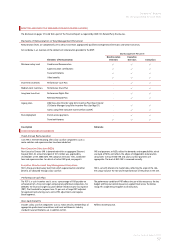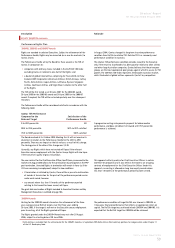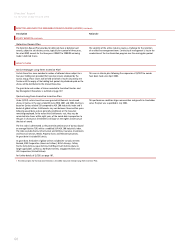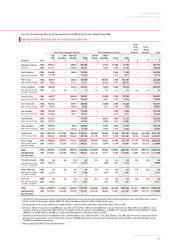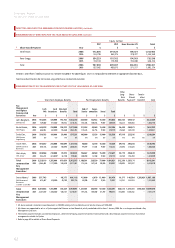Qantas 2006 Annual Report Download - page 56
Download and view the complete annual report
Please find page 56 of the 2006 Qantas annual report below. You can navigate through the pages in the report by either clicking on the pages listed below, or by using the keyword search tool below to find specific information within the annual report.
54
Directors’ Report
for the year ended 30 June 2006
REMUNERATION REPORT
Details of the nature and amount of each major element of the remuneration of each Key Management Personnel (KMP) of Qantas and the Qantas Group and
reference to where they have been incorporated into the Qantas Annual Report is set out below:
Requirement Included in the Qantas Annual Report
Corporations Act
– Remuneration Policy Refer below
– elements of remuneration for each required individual Refer below
Australian Accounting Standards Board (AASB) 2 Share-based Payment
and AASB 124 Related Party Disclosures
– Key Management Personnel Remuneration disclosures Refer below
– Key Management Personnel Equity Benefit disclosures Note 25 to the Financial Report
ASX Corporate Governance Council: Corporate Governance Principle 9
– remunerate fairly and responsibly Refer below
– 2006 Executive Remuneration Philosophy and Objectives Refer below
2006 EXECUTIVE REMUNERATION PHILOSOPHY AND OBJECTIVES
Qantas’ Philosophy for Executive Remuneration is to ensure that
remuneration properly reflects the duties and responsibilities of its
Executives and that remuneration is competitive in attracting, motivating
and retaining people of the highest calibre. As part of this, Executives
should be rewarded for performance and challenged to achieve rigorous
and continuously improving performance targets.
These objectives are achieved via a reward program that involves a mixture of:
• Fixed Annual Remuneration (FAR);
• the Performance Plan, comprising:
i. the Performance Cash Plan (PCP) – a short-term cash incentive; and
ii. the Performance Equity Plan – made up of a medium-term incentive,
the Performance Share Plan (PSP) and a long-term incentive,
the Performance Rights Plan (PRP); and
• Concessionary Travel Entitlements, some targeted retention arrangements
and other discretionary benefi ts considered appropriate from time to time.
The Remuneration Committee (which is a Committee of the Board) plays a
critical role in reviewing and recommending to the Board on matters of
remuneration policy, specifi c recommendations relating to Senior Executives
and all matters concerning equity plans and awards. In doing so, the
Remuneration Committee seeks advice from a range of independent external
specialists. PricewaterhouseCoopers is currently engaged to provide ongoing
independent support to the Remuneration Committee in its deliberations.
The guiding principles in managing remuneration for Executives are that:
• all elements of remuneration should be set at an appropriate level having
regard to market practice for roles of similar scope and skill;
• the Performance Plan should be used to differentiate rewards for high
performers and to encourage continuously higher levels of performance;
• the Performance Plan should be clearly linked to appropriate goals via
a robust performance management system; and
• the Performance Equity Plan should be used to align the interests of
Executives with shareholders, support a culture of employee share
ownership and act as a retention initiative.
Overall, the mix of the remuneration program is consistent with
market practice.
Fixed Annual Remuneration
Salary decisions are based on the concept of FAR, which involves a
guaranteed salary level from which superannuation and certain other
benefits, such as a maintained motor vehicle, are able to be deducted
at the election of the employee on a salary sacrifice basis.
FAR is set with reference to market data, reflecting the scope of the role,
the unique value of the role and the performance of the person in the role.
FAR is reviewed annually and reflects a middle-of-the-market approach, as
compared to similar comparative roles within Australia, having particular
reference to large public companies for the most senior roles.
Reflects industry and market practiceOther benefits eg concessionary travel, discretionary and retention programs
Total Shareholder Return Target allocations to selected Executives
Set with reference to role, market and experience
Group Financial Target
Balanced Scorecard Target
Fixed Annual Remuneration
Performance
Share Plan Operational
Medium-Term
Performance Cash Plan Short-Term
Long-Term
Performance
Rights Plan
Customer People Financial
Performance
Equity Plan
Performance Plan


